GOIN' DOWN SYCAMORE - A Huge Snake, A Civil War Battle And Boom Years
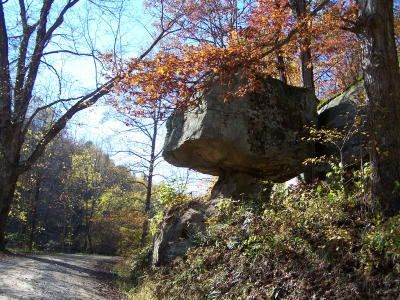
Pinnacle Rock along left fork of Sycamore (Hur Herald Photo)
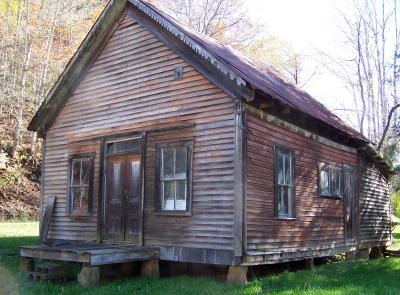
The Morris Store, still standing, in what was once
the main Village of Sycamore (Hur Herald Photo)
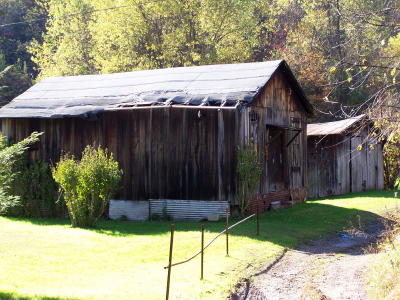
Sycamore's Tripett's Store, adjacent the Morris
Store, from where, during the oil and gas boom,
you could visually see 21 rigs (Hur Herald Photo)
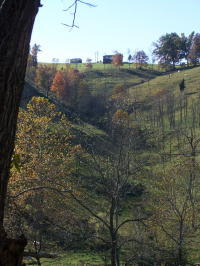
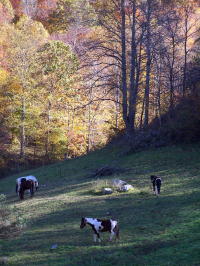
(L) looking from main Sycamore toward the Mt. Zion ridge;
(R) horses grazing on the left fork of Sycamore
By Bob Weaver
Calhoun's Sycamores hold a history of a Civil War battle, an oil and gas boom and a once prosperous village.
There is main Sycamore Creek, with access from Rt. 16 at the County Park (Road Run), extending up the narrow valley back to Rt. 16 at the top of Millstone Hill, and the left fork of Sycamore with access at Russett, extending for several miles to the foot of Millstone Hill and Rt. 16.
The main fork was the location of the Village of Sycamore, which after the Civil War had about 100 residents, a post office, five stores, a couple hotels, two mills and its own doctor and lawyer.
The area prospered with an oil and gas boom in the early part of the 1900s, but is now punctuated with family homes, some new and some old.
The left fork is still sparsely populated, a backwoods area, scenic and peaceful.

The McDonald Homestead on main Sycamore, late 1800s, site
of one of Calhoun's early families (Dan McDonald Photo)

The Sycamore Band, likely during a Sunday afternoon
gathering in early 1900s (David Hathaway Photo)

The burning of the Sycamore Baptist
Church in 1905 (David Hathaway Photo)

Hanning Poling with students at the Poling School, left fork, in 1918
NEWS FROM SYCAMORE (Delayed)
HUGE SNAKE KILLED ON SYCAMORE (1897) - Charley Scott came in from Sycamore last Friday with the biggest snake story we have heard. It seems that J.F. McDonald and a crowd of workmen were mowing and came upon a snake about ten inches in diameter and anywhere from 4 to 10 feet in length, just owing to how bad a man was scared when he saw it.
Several hours of time were employed in making snares and an effort made to capture it alive, but on account of his tremendous size it became necessary to secure an army gun and shoot it.
Under the rock another, but not so large, was found, and by skillful management he was taken alive and kept for some time, but he soon began to show signs of discontent and madness, and at a council of war it was decided to kill him also.
SYCAMORE FIGHT SEVERS HAND (1894) - For sometime, as we understand, there has been a bad feeling between a Mr. Morris, of the head of Sycamore and a family by the name of Everson, residing on the waters of Daniel's Run.
Near the Sycamore post office Mr. John Morris and one of the Everson boys met by accident, and had a few words, when Morris picked up a club and assaulted the boy, who retaliated with an ax, striking Morris with the blade of the ax about the wrist, which all most severed the hand from the arm.
Dr. Dye went out and dressed the wound, and it is thought that it will make a cripple of him, at least. That seems to be an unfortunate community. Near where this fight occurred Jas. Sturm and Sam Sickles went out to settle an old feud, which resulted in the death of Sturm and Sickles a 15 year sentence in the penitentiary, which cost him his life also.
From the knowledge we have of that community we believe a large majority of the citizens are honest and law abiding. But no good citizen nor any number of them can prevent men who are quarrelsome from settling their feuds as they please.
John Morris died of blood poison from the wound that never healed.
PARTISAN RANGERS AND UNION RECRUITS
SKIRMISH AT SYCAMORE (1861) - As battles of the Civil War are measured by later generations, the action on the ridge at the forks of Sycamore Creek at high noon on November 28, 1861, was a very minor affair.
The action was an exchange of gunfire lasting about forty-five minutes between Captain Perry Conley's band of irregular Southern partisans, a splinter group of the Moccasin Rangers, and a detachment of Captain James L. Simpson's Company C, Eleventh (West) Virginia Infantry, which had not yet been mustered into Federal volunteer service.
At just about the noon hour the detachment reached the home of Colonel Adonijah McDonald, late commanding officer of the county's 186th Regiment, Virginia Enrolled Militia, who lived on the divide between the forks of Sycamore, near a log building which served the community in the dual purpose of church and schoolhouse.
The hospitable colonel invited Simpson and his men to dine with him, but as the captain was somewhat pressed for time he accepted only for himself and five of his men. The others were told to go to the homes of nearby residents for their noon meal, scattering out so that no one would he seriously inconvenienced or time lost in mass cooking. Captain Conley had been alerted that the Federals were on the prowl and had hastily mustered his band, drawing on the men of other Moccasin groups, and 40 to 75 went to Sycamore.
Simpson was given a few minutes to prepare for his defense being alerted that Conley's outfit was closing on Sycamore. The rangers opened fire on the McDonald house, pouring in volley after volley, which was returned by the defenders.
Several died in the conflict, which ended with Conley retreating.
The entire saga is reported in Calhoun County in the Civil War on Calhoun's GenWeb Page (see links)